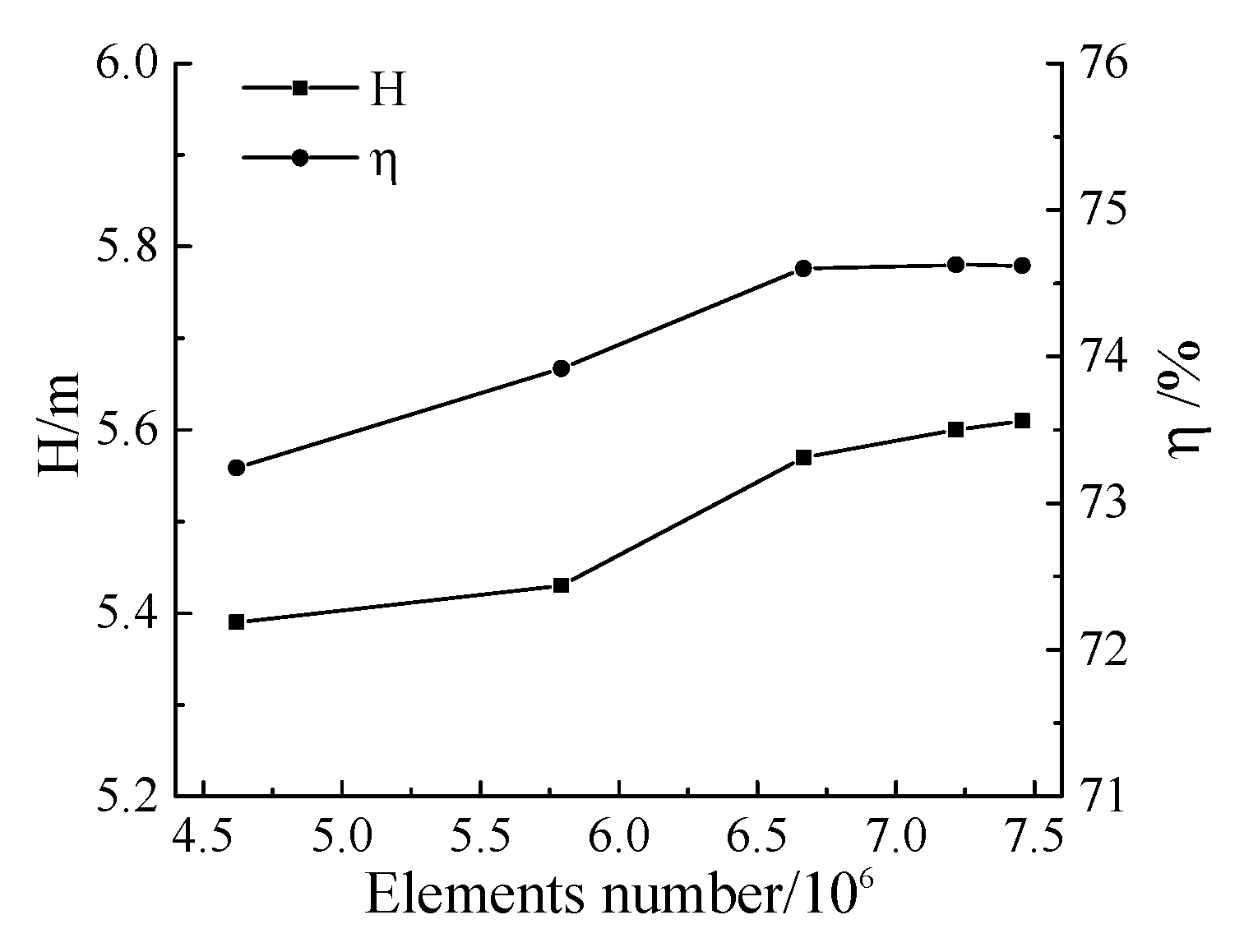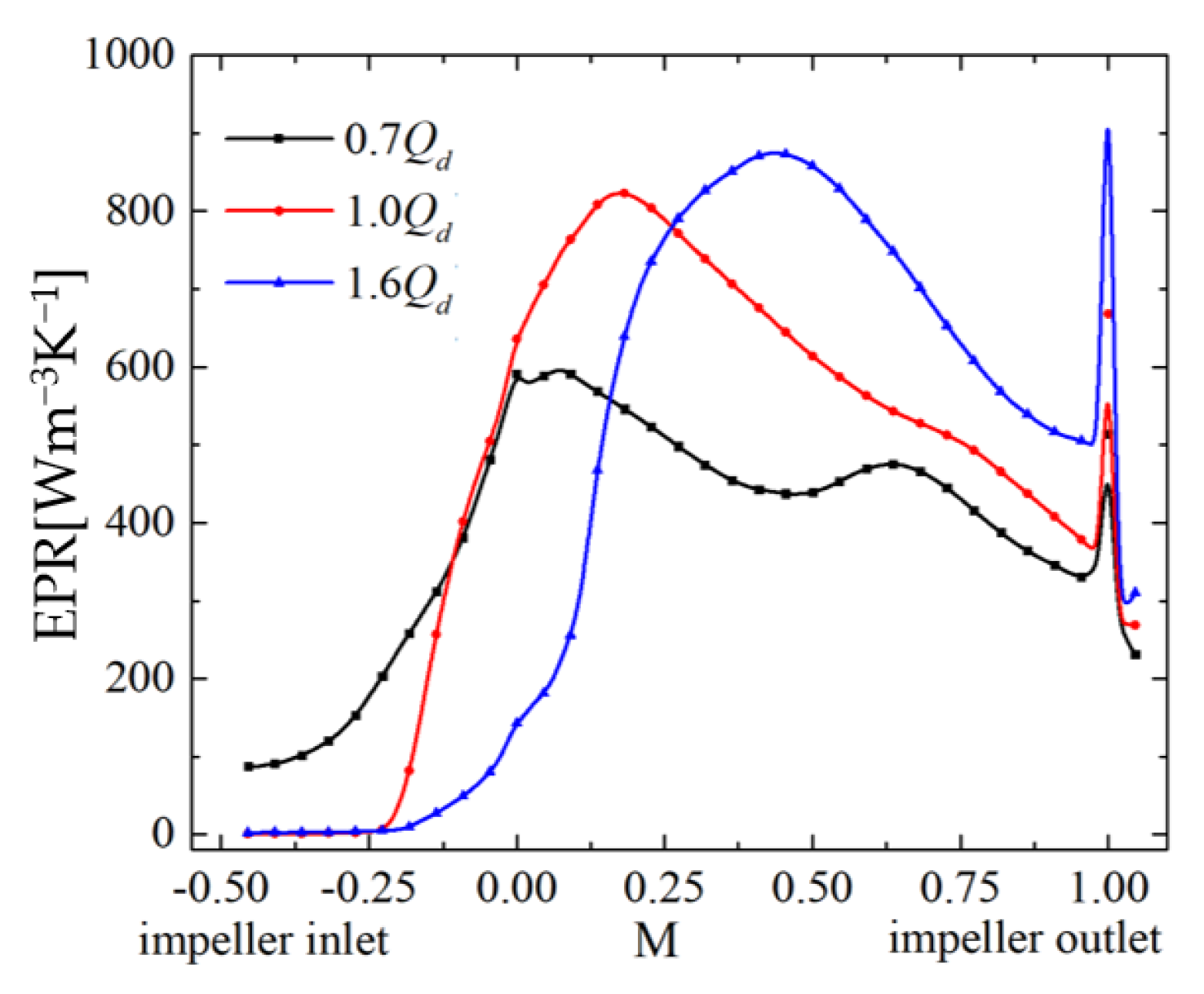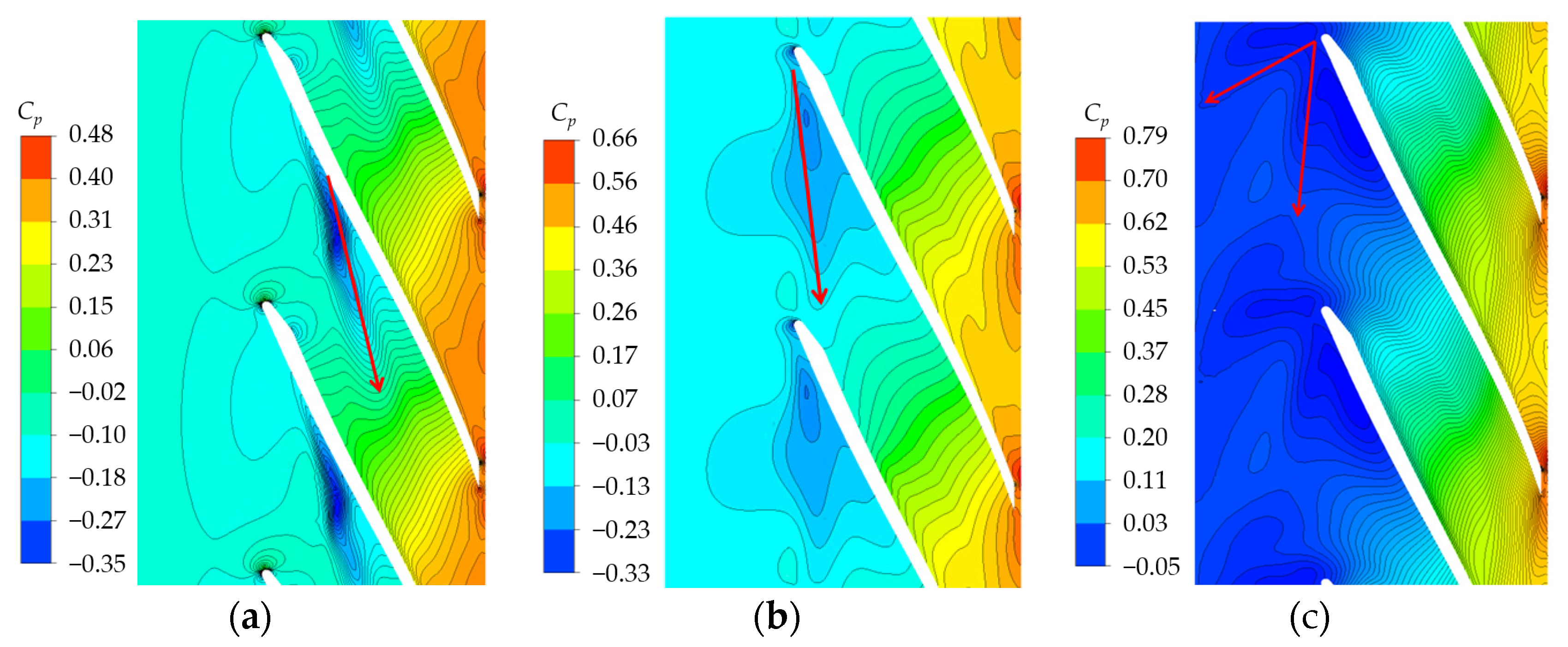Investigation of Tip Leakage Vortex Structure and Trajectory in a Centrifugal Pump with a New Omega Vortex Identification Method
Abstract
:1. Introduction
2. Computational Model and Method
2.1. Specifications of the Pump
2.2. Experimental Setup
2.3. Numerical Setup
2.4. Grid Production
3. Results and Discussion
3.1. Numerical Result Validation
3.2. Vortex Structure
3.3. Internal Flow Field
3.4. TLV Trajectory
4. Conclusions
- (1)
- With the exception of the main leakage vortex, the secondary leakage vortex or even tertiary leakage vortex near the impeller outlet is formed under the high-discharge condition. The vortex structure under the low-discharge condition is more complex than under the high-discharge condition. The indicator of a leakage vortex under the low-discharge condition is a leading-edge overflow phenomenon, which causes a reverse-flow vortex.
- (2)
- The absolute flow angle reflects the flow pattern in the blade inlet. With decreasing discharge, the absolute flow angle increases, and the initial position of the leakage vortex moves forward to the leading edge. An obvious reverse flow is formed under the low-discharge condition, leading to an absolute flow angle close to 180°.
- (3)
- Unstable flow can be characterized by entropy production theory. A region with high EPR is caused by a high-velocity gradient, as well as mixing and rolling up between the tip leakage flow and main flow. With decreased discharge, the peak of the EPR distribution curve moves upstream; this is consistent with the direction of the initial position movement of the TLV. The blade load is reduced, and the distribution law is changed near the tip clearance.
- (4)
- The TLV trajectory is consistent with that of low pressure and the highest-entropy gradient troughs near the shroud. With decreased discharge, the TLV initial position and the interface between the main flow and the leakage flow gradually move upstream. The tip leakage angle increases significantly.
Author Contributions
Funding
Institutional Review Board Statement
Informed Consent Statement
Data Availability Statement
Conflicts of Interest
Nomenclature
| Qd | Design discharge |
| Hd | Design head |
| Hn | Standard helicity |
| M | Meridional distance of blade |
| TLV | Tip leakage vortex |
| PV | Passage vortex |
| BEP | Best efficiency point |
| WV | Wave vortex |
| CV | Corner vortex |
| RVF | Reverse flow vortex |
| EPR | Entropy production rate |
| Cp | Static pressure coefficient |
References
- Huang, S.; Su, X.; Guo, J.; Yue, L. Unsteady numerical simulation for gas–liquid two-phase flow in self-priming process of centrifugal pump. Energy Conv. Manag. 2014, 85, 694–700. [Google Scholar] [CrossRef]
- Wang, L.K.; Lu, J.L.; Liao, W.L.; Zhao, Y.P.; Wang, W. Numerical Simulation of the Tip Leakage Vortex Characteristics in a Semi-Open Centrifugal Pump. Appl. Sci. 2019, 9, 5244. [Google Scholar] [CrossRef] [Green Version]
- Michael, M.; Bernd, W.; Thévenin, D. Effect of tip clearance gap and inducer on the transport of two-phase air-water flows by centrifugal pumps. Exp. Therm. Fluid Sci. 2018, 99, 487–509. [Google Scholar]
- Liu, Y.; Tan, L.; Hao, Y.; Xun, Y. Energy performance and flow patterns of a mixed flow pump with different tip clearance sizes. Energies 2017, 10, 191. [Google Scholar] [CrossRef]
- Zhang, H.; Yang, C.; Yang, D.; Wang, W. Investigation on the Stall Inception Circumferential Position and Stall Process Behavior in a Centrifugal Compressor with Volute. J. Eng. Gas Turb. Power 2019, 141, 021030. [Google Scholar] [CrossRef]
- KC, A.; Lee, Y.; Thapa, B. CFD study on prediction of vortex shedding in draft tube of Francis turbine and vortex control techniques. Renew. Energy 2016, 86, 1406–1421. [Google Scholar] [CrossRef]
- Lu, J.; Wang, L.; Liao, W.; Zhao, Y.; Ji, Q. Entropy Production Analysis for Vortex Rope of a Turbine Model. J. Hydraul. Eng. 2019, 50, 233–241. [Google Scholar]
- Liu, C.; Wang, Y.; Yang, Y.; Duan, Z. New omega vortex identification method. Sci. China Phys. Mech. 2016, 59, 684711. [Google Scholar] [CrossRef]
- Zhang, Y.; Wang, X.; Zhang, Y.; Liu, C. Comparisons of and analyses of vortex identification between omega method and Q criterion. J. Hydrodyn. 2019, 31, 224–230. [Google Scholar] [CrossRef]
- Zhang, Y.; Qiu, X.; Chen, F.; Liu, K.; Dong, X. A selected review of vortex identification methods with applications. J. Hydrodyn. 2018, 30, 767–779. [Google Scholar] [CrossRef]
- Zhang, Y.; Liu, K.; Li, J.; Xian, H.; Du, X. Analysis of the vortices in the inner flow of reversible pump turbine with the new omega vortex identification method. J. Hydrodyn. 2018, 30, 463–469. [Google Scholar] [CrossRef]
- Jia, X.; Cui, B.; Zhang, Y.; Zhu, Z. Study on Internal Flow and External Performance of a Semi-open Impeller Centrifugal Pump with Different Tip Clearances. Int. J. Turbo. Jet-Engines 2015, 32, 1–12. [Google Scholar] [CrossRef]
- Boitel, G.; Fedala, D.; Myon, N. Tip clearance effects on loads and performances of semi-open impeller centrifugal pumps at different specific speeds. Earth Environ. Sci. 2016, 49, 032013. [Google Scholar] [CrossRef]
- Cui, B.; Huang, S.; Shi, P.; Jin, Q. Effect of tip clearance on performance of low specific speed centrifugal pump with semi-open impeller. J. Drain Irrig. Mach. Eng. 2012, 30, 283–288. [Google Scholar]
- Farid, A.; Abdalla, H.; Abou, E. Effect of semi-open impeller side clearance on the centrifugal pump performance using CFD. Aerosp. Sci. Technol. 2015, 47, 247–255. [Google Scholar]
- He, X.; Gong, W.; Deng, J.; Li, J.; Liang, L. Influence of Impeller Tip Clearance on the Performance of Centrifugal Refrigeration Compressor. J. Xi’an Jiaotong Univ. 2019, 53, 30–37. [Google Scholar]
- Yang, C.; Shan, S.; Li, D. Inlet Recirculation Influence to the Flow Structure of Centrifugal Impeller. Chin. J. Mech. Eng. 2010, 23, 647–654. [Google Scholar] [CrossRef]
- Zhao, H.; Wang, Z.; Xi, G. Unsteady flow structures in the tip region for a centrifugal compressor impeller before rotating stall. Sci. China-Technol. Sci. 2017, 60, 122–132. [Google Scholar] [CrossRef]
- Wu, Y.; Li, Q.; Chu, W.; Su, Z. Numerical investigation of the unsteady behaviour of tip clearance flow and its possible link to stall inception. Proc. Inst. Mech. Eng. Part A-J. Power Energy 2010, 224, 85–96. [Google Scholar] [CrossRef]
- Zhang, Y.; Lu, X.; Chu, W.; Zhu, J. Numerical Investigation of the Unsteady Tip Leakage Flow and Rotating Stall Inception in a Transonic Compressor. J. Therm. Sci. 2010, 19, 310–317. [Google Scholar] [CrossRef]
- Lu, J.; Guo, L.; Wang, L.; Wang, W.; Guo, P.; Luo, X. Research on the Unsteady Flow of Tip Clearance in Semi-open Impeller Centrifugal Pump. Trans. Chin. Soc. Agric. Eng. 2019, 50, 163–172. [Google Scholar]
- Xu, Y.; Tan, L.; Liu, Y.; Hao, Y.; Zhu, B.; Cao, S. Pressure fluctuation and flow pattern of a mixed flow pump with different blade tip clearances under cavitation condition. Adv. Mech. Eng. 2017, 9. [Google Scholar] [CrossRef]
- Li, X.; Yuan, S.; Pan, Z.; Li, Y.; Liu, W. Dynamic Characteristics of Rotating Stall in Mixed Flow Pump. J. Appl. Math. 2013, 10, 4819–4828. [Google Scholar] [CrossRef]
- Wang, L.; Lu, J.; Liao, W. Numerical investigation on vibration and pressure fluctuation characteristics in a centrifugal pump under low flow rate. Proc. Inst. Mech. Eng. Part C J. Mech. Eng. Sci. 2021, 235, 3888–3899. [Google Scholar] [CrossRef]
- Chen, G.; Greitzer, E.; Tan, C. Similarity Analysis of Compressor Tip Clearance Flow Structure. J. Turbo 1991, 113, 260–269. [Google Scholar] [CrossRef]
- Matzgeller, R.; Burgold, Y. Investigation of Compressor Tip Clearance Flow Structure. In Proceedings of the ASME Turbo Expo 2010: Power for Land, Sea, and Air, Glasgow, UK, 14–18 June 2010; Volume 7: Turbomachinery, Parts A, B, and C, pp. 455–464. [Google Scholar]
- Zhao, H.; Wang, Z.; Ye, S.; Xi, G. Numerical investigations on tip leakage flow characteristics and vortex trajectory prediction model in centrifugal compressor. Proc. Inst. Mech. Eng. Part A-J. Power Energy 2016, 230, 757–772. [Google Scholar] [CrossRef]
- Iwakiri, K.; Furukawa, M.; Ibaraki, S.; Tomita, I. Unsteady and Three-Dimensional Flow Phenomena in a Transonic Centrifugal Compressor Impeller at Rotating Stall. In Proceedings of the ASME Turbo Expo 2009: Power for Land, Sea, and Air, Orlando, FL, USA, 8–12 June 2009; Volume 7: Turbomachinery, Parts A and B, pp. 1611–1622. [Google Scholar]
- Hong, S.; Huang, G.; Lu, W.; Yang, Y. Flow Characteristics of a Centrifugal Compressor in near Stall Condition and Rolling up Vortex Model of Tip Leakage Vortex. J. Prop. Tech. 2018, 39, 78–86. [Google Scholar]
- Jia, X.; Zhu, Z.; Yu, X.; Zhang, Y. Internal unsteady flow characteristics of centrifugal pump based on entropy generation rate and vibration energy. Proc. Inst. Mech. Eng. Part E-J. Process. Mech. Eng. 2019, 233, 456–473. [Google Scholar] [CrossRef]
- Behzadmehr, A.; Mercadier, Y. Numerical study of flow parameters and entropy generation on a centrifugal fan. Int. J. Exergy 2009, 6, 80–92. [Google Scholar] [CrossRef]
- Li, D.; Wang, H.; Qin, Y.; Han, L.; Wei, X.; Qin, D. Entropy production analysis of hysteresis characteristic of a pump-turbine model. Energy Conv. Manag. 2017, 149, 175–191. [Google Scholar] [CrossRef]















Publisher’s Note: MDPI stays neutral with regard to jurisdictional claims in published maps and institutional affiliations. |
© 2022 by the authors. Licensee MDPI, Basel, Switzerland. This article is an open access article distributed under the terms and conditions of the Creative Commons Attribution (CC BY) license (https://creativecommons.org/licenses/by/4.0/).
Share and Cite
Qian, B.; Cai, Y.; Ding, Q.; Zhao, D.; Sun, W.; Wang, L. Investigation of Tip Leakage Vortex Structure and Trajectory in a Centrifugal Pump with a New Omega Vortex Identification Method. Appl. Sci. 2022, 12, 5270. https://doi.org/10.3390/app12105270
Qian B, Cai Y, Ding Q, Zhao D, Sun W, Wang L. Investigation of Tip Leakage Vortex Structure and Trajectory in a Centrifugal Pump with a New Omega Vortex Identification Method. Applied Sciences. 2022; 12(10):5270. https://doi.org/10.3390/app12105270
Chicago/Turabian StyleQian, Bing, Yinhui Cai, Qiang Ding, Daoli Zhao, Weipeng Sun, and Like Wang. 2022. "Investigation of Tip Leakage Vortex Structure and Trajectory in a Centrifugal Pump with a New Omega Vortex Identification Method" Applied Sciences 12, no. 10: 5270. https://doi.org/10.3390/app12105270
APA StyleQian, B., Cai, Y., Ding, Q., Zhao, D., Sun, W., & Wang, L. (2022). Investigation of Tip Leakage Vortex Structure and Trajectory in a Centrifugal Pump with a New Omega Vortex Identification Method. Applied Sciences, 12(10), 5270. https://doi.org/10.3390/app12105270





